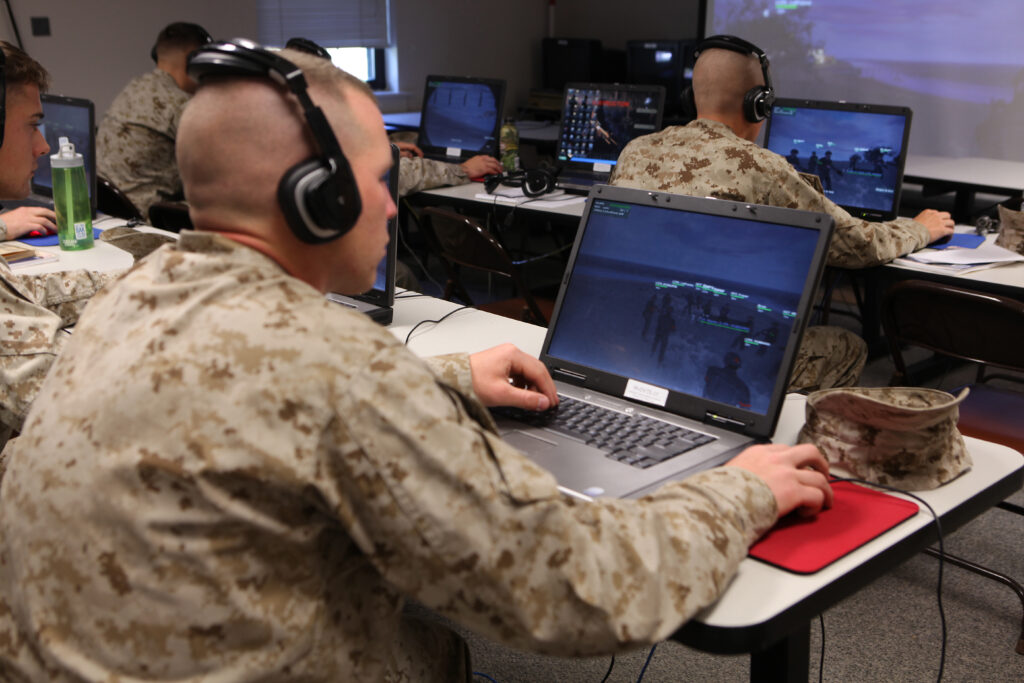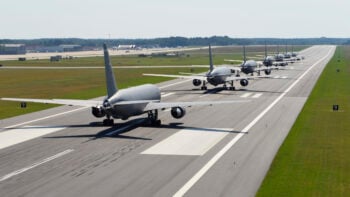
Marine officers training in command in simulated scenarios.
WASHINGTON: From the Navy’s sprawling Fallon training range in Nevada, to Marine Corps Battle Simulation Centers, to the cockpits of individual F-18 fighter jets, the Navy and Marines are upgrading training technology to capture the complexity and scale of future war.
Real-world field exercises are no longer enough because even the largest training areas are too small to hold the long-range missile duels envisioned by concepts like Naval Integrated Fire Control and Army Strategic Fires. Submarines and F-18s will get hypersonic missiles, dramatically extending the ranges at which they can kill targets. (Such missiles are also too costly to live-fire in large numbers during training). Traditional simulations are stovepiped, each built to train a specific system and skillset – pilots, for example, or Aegis missile defense operators, or supply officers — so they don’t depict how those systems interact in actual conflict.
Now, the sea services haven’t publicly embraced the concept of Joint All-Domain Command & Control (JADC2) — a meta-network coordinating operations across land, sea, air, space, and cyberspace — as enthusiastically as the Army and Air Force. The Marines already operate on land, sea, and air and have units with organic capabilities, while the Navy is increasingly linking air, surface, and submarine forces, and the sea services’ new Project Overmatch effort will plug into JADC2. Their existing training systems simply weren’t built to replicate this new kind of interconnected combat.

Lt. Gen. Lewis Craparotta
The Marine Corps’ approach, for now, is to upgrade and integrate existing simulations and live-training ranges into a single unified network by 2024, Lt. Gen. Lewis Craparotta, the new chief of Training & Education Command, said. TECOM looked at creating an all-new training and simulation system from scratch, he told the vIITSEC training & simulation conference Monday, “[but] frankly, there’s just too much that’s already out there for us to start over.”
The 2024 upgrade – what Craparotta called “our Live-Virtual-Constructive Training Environment, Increment One” – will build a dedicated network to link existing Battle Simulation Centers at Marine Corps bases around the country. Increment One’s focus is on battalion and regimental-scale wargames, the general said. The Marines know future conflict will occur on a larger scale than that, but their division/Marine Expeditionary Force-level simulations require significant “reengineering” and will only be brought in during an Increment Two, for which he didn’t give definite dates.
The Navy, meanwhile, has already upgraded its existing training hub in Fallon, whose website boasts it’s “the only facility in existence where an entire carrier air wing can conduct comprehensive training” together. Now, said Vice Adm. Mike Moran, the Navy’s top uniformed acquisition official and a proponent of linking different networks, “for the first time, we really can bring our AEGIS guys in with our F-18 and E-2D folks.” That means it’s not just the air wing, he said, but also a Carrier Strike Group’s shipboard AEGIS operators, training both with live aircraft physically flying over Fallon and with simulated ones.
The Navy has also installed new software in its F-18 Super Hornet fighters, which allows a single aircraft to take off on a training flight by itself and interact with a host of simulated friends and foes. “We’re getting… rave feedback” from the first units to adopt the new in-cockpit technology, Moran told the conference, and the service will soon start installing it in the E-2D radar early-warning planes as well.
Without this new technology, the admiral said, the Navy can’t adequately train for the sheer reach and complexity of its newly fielded Naval Integrated Fire Control – Counter Air system (NIFC-CA) and the associated Concepts of Operations (CONOPS).
“It is a very complex CONOPS for the fleet to execute — effective, but it is complex,” Moran told the conference. “We got that feedback pretty quickly.
“We’re really looking at really complex capabilities that enable us to be more effective in the fight, but we have to provide the training packages to enable… the fleet to execute them effectively,” he continued. “So that’s a big investment and a focus area for us.”
The Marines, likewise, envision far more complex and wide-ranging operations in any future operations against China and Russia than the village-by-village guerrilla warfare in Afghanistan for which the Marines have spent much of the last 20 years training for. “To properly prepare for peer adversaries, we have to be able to train…at scale,” Craparotta said. “This means large headquarters and expansive training audiences, integrating capabilities across five domains, integrating people across our bases and stations and around the globe.”
“We can’t really do that today without a lot of front-end work, and even if we do front-end work, we can only do it for short periods of time,” he told the conference. The goal, he said, is to give Marine units access to complex training on demand, “24-7.”
“I think the initial integration of individual collective and staff training simulations on a dedicated network, we think, can be delivered as part of increment one by 2024,” Craparotta said. Beyond that, he said, the Marines want to link not just the Simulation Centers but other training simulations and live exercises at ranges around the world. “We don’t currently possess the systems or the network capabilities to support Increment Two,” he said, “[but] that’s the direction that we’re heading.”






















